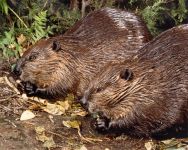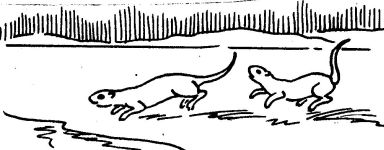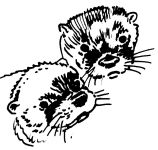


|

|
|
 
|
by Hope Sawyer Buyukmihci, 1972
Published in the November 2012 issue of The Beaver Defenders
One August morning from my cabin window overlooking the beaver pond, I saw the water move in giant swells. Then came high-pitched chirping. Creeping out the door and crouching low, I moved to the shore, where from behind a tangle of honeysuckle I could view the pond. There were two otter cubs, less than 20 feet away, dipping among the lilies and wild rice. Now and then they held up periscope-like heads tufted with whiskers, and gave companionable chirps of pleasure and discovery.
These youngsters, born perhaps as early as February, had grown to three-quarters adult size. They resembled long, sleek house cats with small ears and wet fur. This was not the first time I had seen them. They often swam up or down stream in close formation with their parents, who guarded them fore and aft. Both adults and young then kept up a mellow, duck-like quacking.

That August day I wondered what otter cubs were doing on their own, for I had heard that the family stays together for a year. I soon found out. An adult otter appeared, swimming far out in the pond, head high, looking frantically this way and that, her tail standing straight in the air. Back and forth she charged, 300 feet away, while the two cubs dallied among the lilies, Suddenly she swerved and raced toward them with excited snorts. The young ones hurried to meet her, and after a flurry of nose-touching the three went undulating off.
An adult otter can weigh up to 25 pounds and has rich reddish-brown fur with a buff-colored crescent at the throat. His foot-long tail is thick and rounded at the end, and is a powerful part of his swimming equipment. And at swimming, otters have the grace of seals.
Infant otters are more helpless than beavers, being born without fur and blind. They nurse for four months, twice as long as beaver kits, and are dependent on their parents much longer. Strangely, the otters who will eventually out-swim and out-dive the beavers, must be taught to swim, while beaver babies are ready to slide right into the water, eyes open, at birth. The mother otter, it is said, carries her cubs on her back into the water, then submerges, leaving them to flounder an squeak. They soon learn to swim.
Although the myth that otters are deadly enemies to beavers still persists, it is fading in the light of recent findings. My own experience is of one batch of beaver kittens after another being raised without mishap in the presence of otters. Emil Liers, "The Otter Man" of Minnesota, says "Otters who burrow into a beaver lodge are often after crustaceans. If a beaver is killed by an otter it is the exception to the rule."

One day at sunrise, while observing a father beaver shoring up his woodland dam, I noticed two of his kittens playing just before a bend 50 feet up the stream. As I watched, the water at the bend was agitated, and a pair of adult otters with two half-grown cubs swept into sight. One of the cubs barked a greeting – like a high-pitched puppy yap – and rushing headlong to where one of the beaver kits sat on shore combing his fur, chased the young beaver into the water. A boisterous session followed as kittens and cubs played tag in the water, the beaver kits displaying good-natured tolerance of the lively cubs, who yipped and chirped with excitement, swimming circles around, under and over the kits.
While the four youngsters frolicked, the father beaver continued methodically plastering his dam, and the parent otters, long and agile, looped smoothly about the pool or ran along the shore before sliding back in. Soon the otter family moved on downstream, with the exuberant cubs sandwiched as usual between their watchful parents.
On many occasions I have seen otters and beavers mingle, neither species showing concern about the presence of the other. Once I saw an otter cub who had evidently mistaken a mother beaver for his own. At sundown a group of otters came galloping over the dike and into the pond, paying no attention to a mother beaver and her five kittens, to whom I was feeding poplar at the dike. Soon after they passed, I noticed a youngster swimming rapidly all around the mother beaver. Puzzled, I counted noses and found that all five kittens were at my feet. Who then was circling the big beaver?
Came a piercing yip, and I realized that the swimmer must be an otter cub. As he continued to circle, dipping in and out, yipping in frenzy each time he came to the surface, the mother beaver kept on eating in her usual tranquil manner. Meanwhile, the otter family was traveling far up the pond, leisurely feeding as they went. After a few more minutes of enduring the mother beaver's indifference, the cub stopped crying, swam about uncertainly, then sped to catch up with his family.
Otters may feed on fish, frogs, crustaceans, turtles, snakes, muskrats, ducks and other aquatic life. I have seen them furnish food to others, too, for they are often accompanied by bevies of green herons who snatch morsels from almost under their chins. The otters never seem to mind.
Some fishermen still believe that otters are a menace to their fishing, but this idea has been disproved. In fact, fishing is often better where otters are present as they keep fish populations healthy, as they did for centuries before man's interference. Otters do sometimes invade man-operated hatcheries, but this intrusion can be prevented by an otter-proof fence.
So many books have been written about the otter's playful habits that his name is almost synonymous with "play." "Joyful, keen and fearless," as Earnest Thompson Seton called him, "mild and loving to his own kind, and gentle with his neighbor of the stream."